Chapter 9: Cellular Respiration and Fermentation
1/106
There's no tags or description
Looks like no tags are added yet.
Name | Mastery | Learn | Test | Matching | Spaced |
|---|
No study sessions yet.
107 Terms
What is the term for metabolic pathways that release stored energy by breaking down complex molecules?
A) anabolic pathways
B) catabolic pathways
C) fermentation pathways
D) thermodynamic pathways
E) bioenergetic pathways
B
What is the term used for the metabolic pathway in which glucose (C6O12H6) is degraded to carbon dioxide (CO2) and water?
A) cellular respiration
B) glycolysis
C) fermentation
D) citric acid cycle
E) oxidative phosphorylation
A
Which of the following statements concerning the metabolic degradation of glucose (C6H12O6) to carbon dioxide (CO2) and water is (are) true?
A) the breakdown of glucose to carbon dioxide and water is exergonic
B) the breakdown of glucose to carbo dioxide and water has a free energy change of -686 kcal/mol
C) the breakdown of glucose to carbon dioxide and water involves oxidation-reduction or redox reactions
D) only A and B are correct
E) A, B, and C are correct
E
Which of the following statements is (are) correct about an oxidation-reduction (or redox) reaction?
A) the molecule that is reduced gain electrons
B) the molecule that is oxidized loses electrons
C) the molecule that is reduced loses electrons
D) the molecule that is oxidized gains electrons
E) both A and B are correct
E
Which statement is not correct with regard to redox (oxidation-reduction) reactions?
A) A molecule is reduced if it loses electrons.
B) A molecule is oxidized if it loses electrons.
C) An electron donor is called a reducing agent.
D) An electron acceptor is called an oxidizing agent.
E) Oxidation and reduction always go together.
A
The molecule that functions as the reducing agent (electron donor) in a redox or oxidation-reduction reaction
A) gains electrons and gains energy.
B) loses electrons and loses energy.
C) gains electrons and loses energy.
D) loses electrons and gains energy.
E) neither gains nor loses electrons, but gains or loses energy.
B
When electrons move closer to a more electronegative atom, what happens?
A) Energy is released.
B) Energy is consumed.
C) The more electronegative atom is reduced.
D) The more electronegative atom is oxidized.
E) A and C are correct.
E
Why does the oxidation of organic compounds by molecular oxygen to produce CO? and water release free energy?
A) The covalent bonds in organic molecules are higher energy bonds than those in water and carbon dioxide.
B) Electrons are being moved from atoms that have a lower affinity for electrons (such as C) to atoms with a higher affinity for electrons (such as O).
C) The oxidation of organic compounds can be used to make ATP.
D) The electrons have a higher potential energy when associated with water and COp than they do in organic compounds.
E) The covalent bond in O2 is unstable
and easily broken by electrons from organic molecules.
B
Which of the following statements describes the results of this reaction?
C6H12O6 + 6 O2 > 6 CO? + 6 H2O + Energy
A) C6H12O6 is oxidized and O9 is reduced.
B) O2 is oxidized and H2O is reduced.
C) CO is reduced and O2 is oxidized.
D) C6H1206 is reduced and CO2 is oxidized.
E) O2 is reduced and CO2 is oxidized.
A
When a glucose molecule loses a hydrogen atom (not a hydrogen ion) as the result of an oxidation-reduction reaction, the molecule becomes
A) dehydrogenated.
B) hydrogenated.
C) oxidized.
D) reduced.
E) an oxidizing agent.
C
When a molecule of NAD* (nicotinamide adenine dinucleotide) gains a hydrogen atom (not a hydrogen ion) the molecule becomes
A) hydrogenated.
B) oxidized.
C) reduced.
D) redoxed.
E) a reducing agent.
C
Which of the following statements about NAD? is false?
A) NAD? is reduced to NADH during both glycolysis and the citric acid cycle.
B) NAD* has more chemical energy than NADH.
C) NAD+ is reduced by the action of dehydrogenases.
D) NAD* can receive electrons for use in oxidative phosphorylation.
E) In the absence of NAD*, glycolysis cannot function.
B
In order for NAD* to remove electrons from glucose or other organic molecules, which of the following must be true?
A) The organic molecule or glucose must be negatively charged in order to
reduce the positively charged NAD*. B) Oxygen must be present to oxidize the NADH produced back to NADTt.
C) The free energy liberated when electrons are removed from the organic molecules must be greater than the energy required to give the
electrons to NADT.
D) A and B are both correct.
E) A, B, and C are all correct
C
Where does glycolysis takes place?
A) mitochondrial matrix
B) mitochondrial outer membrane
C) mitochondrial inner membrane
D) mitochondrial intermembrane space
E) cytosol
E
The ATP made during glycolysis is generated by
A) substrate-level phosphorylation.
B) electron transport.
C) photophosphorylation.
D) chemiosmosis.
E) oxidation of NADH to NAD*
A
The oxygen consumed during cellular respiration is involved directly in which process or event?
A) glycolysis
B) accepting electrons at the end of the electron transport chain
C) the citric acid cycle
D) the oxidation of pyruvate to acetyl CoA
E) the phosphorylation of ADP to form ATP
B
Which process in eukaryotic cells will proceed normally whether oxygen (O2) is present or absent?
A) electron transport
B) glycolysis
C) the citric acid cycle
D) oxidative phosphorylation
E) chemiosmosis
B
Which of the following statements about glycolysis false?
A) Glycolysis has steps involving oxidation-reduction reactions.
B) The enzymes of glycolysis are located in the cytosol of the cell.
C) Glycolysis can operate in the complete absence of O2.
D) The end products of glycolysis are CO9 and H90.
E) Glycolysis makes ATP exclusively through substrate-level phosphorylation..
D
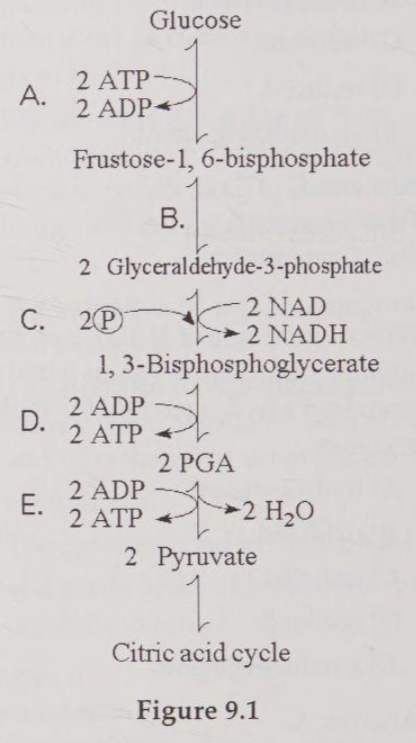
Figure 9.1 illustrates some of the steps (reactions) of glycolysis in their proper sequence. Each step is lettered. Use these letters to answer the questions. Which step shows a split of one molecule into two smaller molecules?
B

In which step is an inorganic phosphate added to the reactant?
C
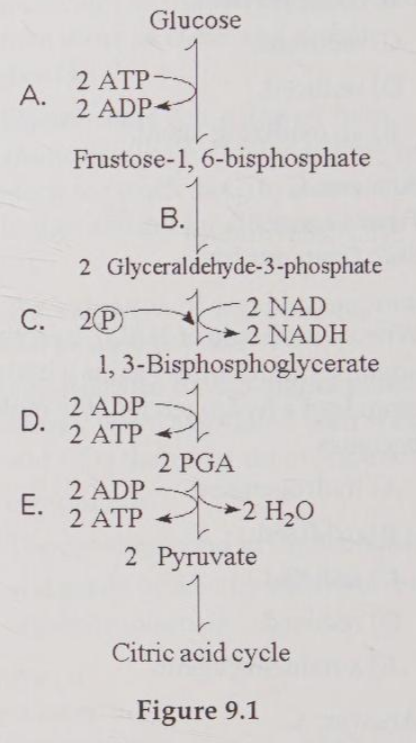
In which reaction does an intermediate pathway become oxidized?
C

Which step involves an endergonic reaction?
A
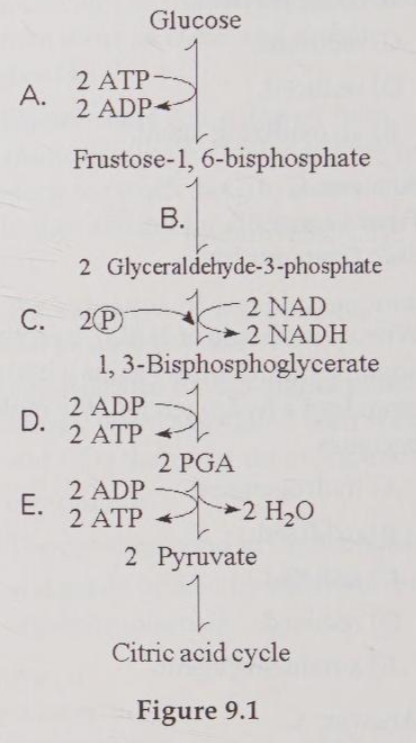
Which step consists of a phosphorylation reaction in which ATP is the phosphate source?
A
Substrate-level phosphorylation accounts for approximately what percentage of the ATP formed during glycolysis?
A) 0%
B) 2%
C) 10%
D) 38%
E) 100%
E
During glycolysis, when glucose is catabolized to pyruvate, most of the energy of glucose is
A) transferred to ADP, forming ATP.
B) transferred directly to ATP.
C) retained in the pyruvate.
D) stored in the NADH produced.
E) used to phosphorylate fructose to form fructose-6-phosphate.
C
In addition to ATP, what are the end products of glycolysis?
A) CO? and H2O
B) CO? and pyruvate
C) NADH and pyruvate
D) CO2 and NADH
E) H20, FADH2, and citrate
C
The free energy for the oxidation of glucose to CO? and water is -686 kcal/mole and the free energy for the reduction of NAD+ to NADH is +53 kcal/mole. Why are only two molecules of NADH formed during glycolysis when it appears that as many as a dozen could be formed?
A) Most of the free energy available from the oxidation of glucose is used in the production of ATP in glycolysis.
B) Glycolysis is a very inefficient reaction, with much of the energy of glucose released as heat.
C) Most of the free energy available from the oxidation of glucose remains in pyruvate, one of the products of glycolysis.
D) There is no CO2 or water produced as products of glycolysis.
E) Glycolysis consists of many enzymatic reactions, each of which extracts some energy from the glucose molecule.
C
Starting with one molecule of glucose, the “net” products of glycolysis are
A) 2 NAD+, 2H+, 2 pyruvate, 2 ATP, and 2 H2O
B) 2 NADH, 2 H+, 2 pyruvate, 2 ATP, and 2 H2O
C) 2 FADH2, 2 pyruvate, 4 ATP, and 2 H2O
D) 6 CO2, 6H2O, 2 ATP, and 2 pyruvate
E) 6 CO2, 6 H2O, 36 ATP, and 2 citrate
B
In glycolysis, for each molecule of glucose oxidized to pyruvate
A) 2 molecules of ATP are used and 2 molecules of ATP are produced
B) 2 molecules of ATP are used and 4 molecules of ATP are produced
C) 4 molecules of ATP are used and 2 molecules of ATP are produced
D) 2 molecules of ATP are used and 6 molecules of ATP are produced
E) 6 molecules of ATP are used and 6 molecules of ATP are produced
B
A molecule that is phosphorylated
A) has an increased chemical reactivity; it is primed to do cellular work
B) has a decreased chemical reactivity,; it is less likely to provide energy for cellular work
C) has been oxidized as a result of a redox reaction involving the gain of an inorganic phosphate
D) has been reduced as a result of a redox reaction involving the loss of an inorganic phosphate
E) has less energy than before its phosphorylation and therefore less energy for cellular work
A
Which kind of metabolic poison would most directly interfere with glycolysis?
A) an agent that reacts with oxygen and depletes its concentration in the cell
B) an agent that binds to pyruvate and inactivates it
C) an agent that closely mimics the structure of glucose but is not metabolized
D) an agent that reacts with NADH and oxidized it to NAD+
E) an agent that blocks the passage of electrons through the electron transport chain
C
In the presence of oxygen, the three-carbon compound pyruvate can be catabolized in the citric acid cycle. First, however, the pyruvate 1) loses a carbon, which is given off as a molecule of CO2, 2) is oxidized to form a two-carbon compound called acetate, and 3) is bonded to coenzyme A. These three steps result in the formation of
A) acetyl CoA, O2, and ATP.
B) acetyl CoA, FADH2, and CO2
C) acetyl CoA, FAD, H2, and CO2
D) acetyl CoA, NADH, H+, and CO2
E) acetyl CoA, NAD+, ATP, and CO2
D
Which of the following intermediary metabolites enters the citric acid cycle and is formed, in part, by the removal of a carbon (CO2) from one molecule of pyruvate?
A) lactate
B) glyceraldehydes-3-phosphate
C) oxaloacetate
D) acetyl CoA
E) citrate
D
During cellular respiration, acetyl CoA accumulates in which location?
A) cytosol
B) mitochondrial outer membrane
C) mitochondrial inner membrane
D) mitochondrial intermembrane space
E) mitochondrial matrix
E
How many carbon atoms are fed into the citric acid cycle as a result of the oxidation of one molecule of pyruvate?
A) 2
B) 4
C) 6
D) 8
E) 10
A
All of the following are functions of the citric acid cycle except
A) production of ATP.
B) production of NADH.
C) production of FADH2.
D) release of carbon dioxide.
E) adding electrons and protons to oxygen, forming water.
E
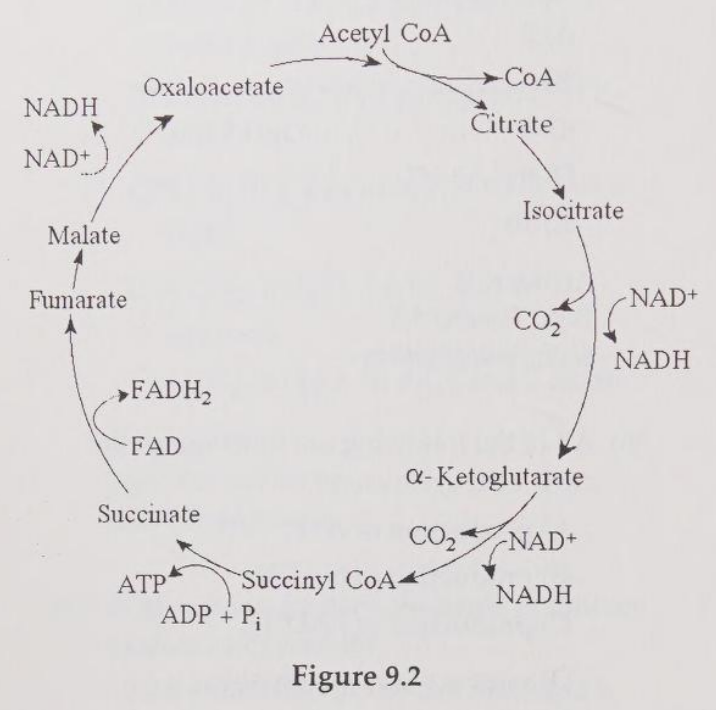
Starting with one molecule of isocitrate and ending with fumarate, what is the maximum number of ATP molecules that could be made through substrate-level phosphorylation?
A)1
B) 2
C) 11
D) 12
E) 24
A
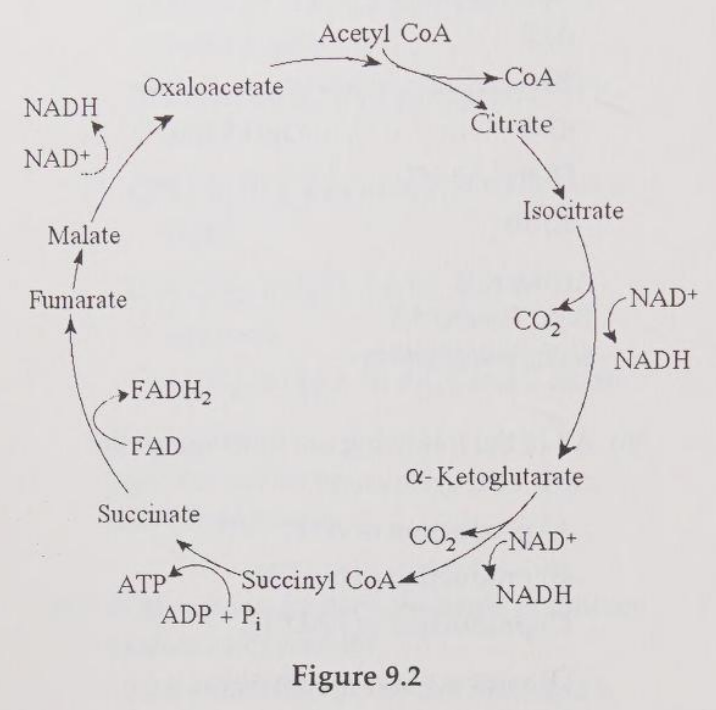
Carbon skeletons for amino acid biosynthesis are supplied by intermediates of the citric acid cycle. Which intermediate would supply the carbon skeleton for synthesis of a five-carbon amino acid?
A) succinate
B) malate
C) citrate
D) a-ketoglutarate
E) isocitrate
D
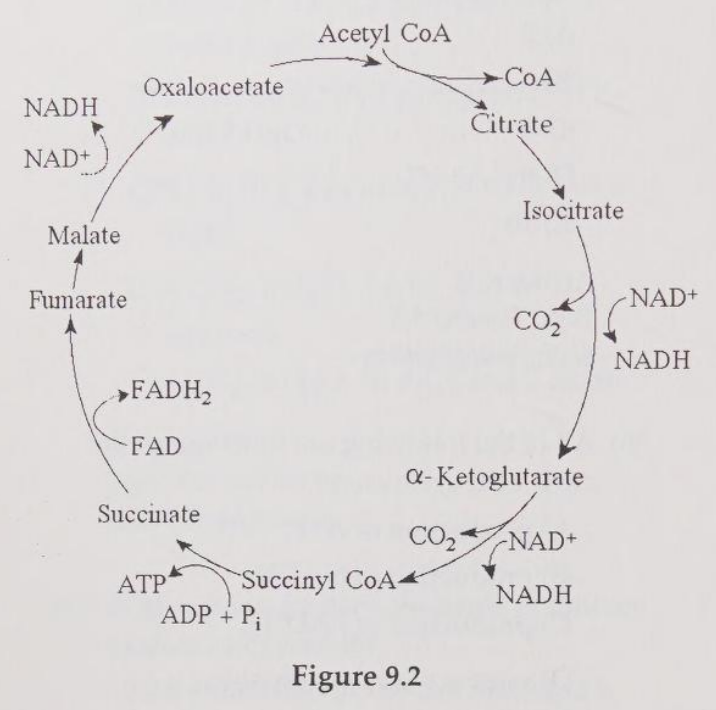
Starting with one molecule of citrate and ending with oxaloacetate, how many ATP molecules can be formed from oxidative phosphorylation (chemiosmosis)?
A) 1
B) 3
C) 4
D) 11
E) 12
D
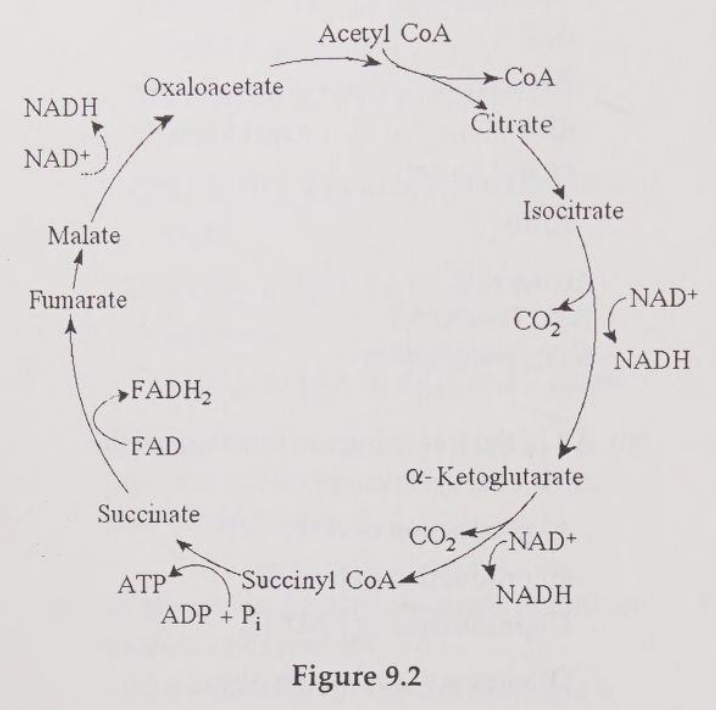
How many ATP molecules could be made through substrate-level phosphorylation plus oxidative phosphorylation (chemiosmosis) if you started with three molecules of succinyl CoA and ended with oxaloacetate?
A) 6
B) 12
C) 18
D) 24
E) 36
C
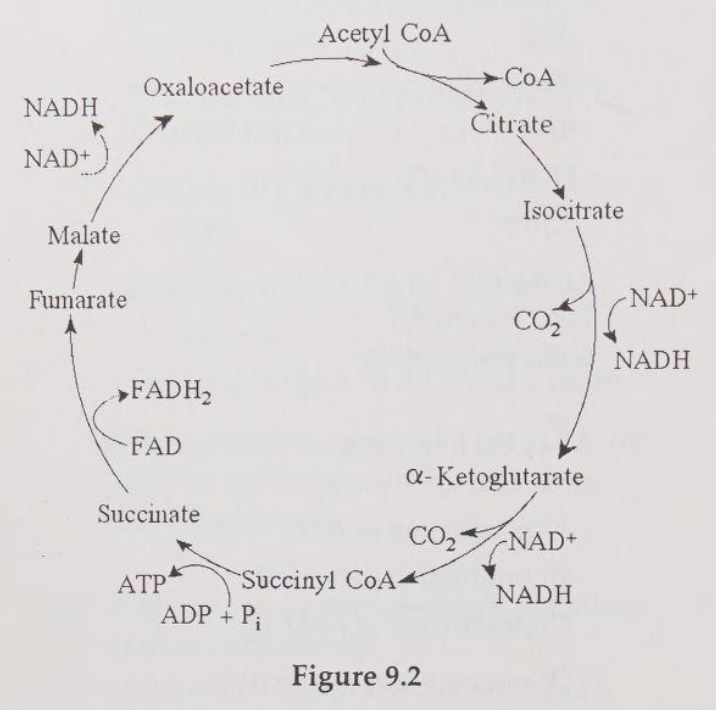
How many molecules of carbon dioxide (CO2) would be produced by five turns of the citric acid cycle?
A) 2
B) 5
C) 10
D) 12
E) 60
C
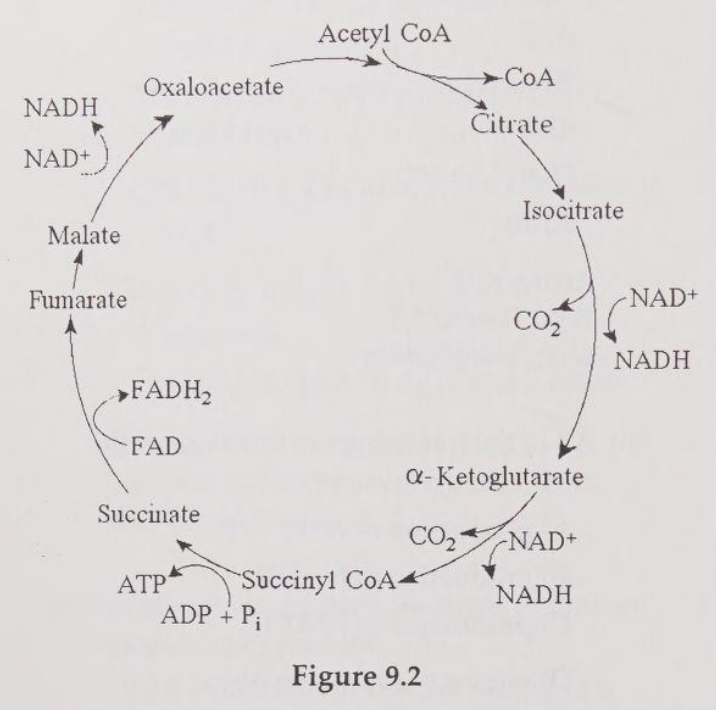
How many reduced nucleotides would be produced with four turns of the citric acid cycle?
A) 1 FADH2 and 4 NADH
B) 2 FADH2 and 8 NADH
c) 4 FADH2 and 12 NADH
D) 1 FAD and 4 NAD+
E) 4 FAD+ and 12 NAD+
C
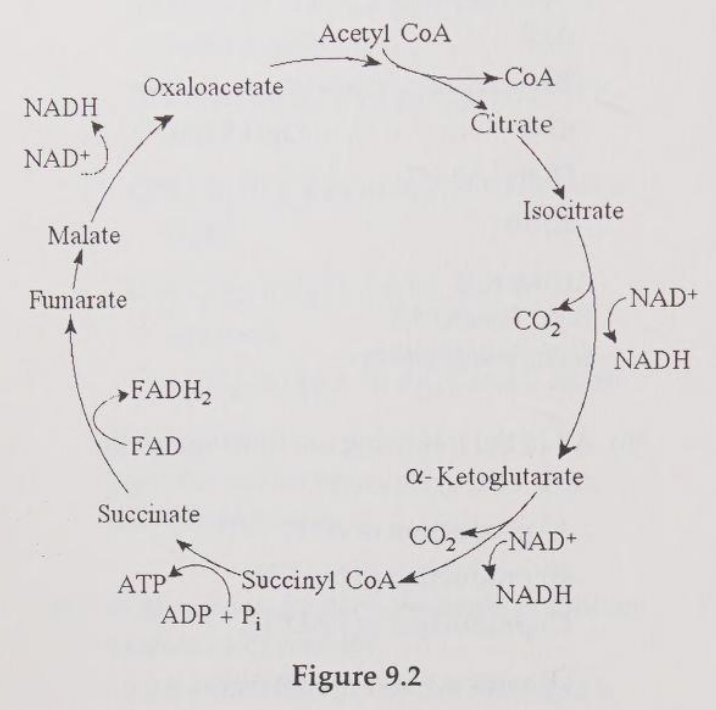
Starting with citrate, how many of the following would be produced with three turns of the citric acid cycle?
A) 1 ATP, 2 CO2, 3 NADH, and 1 FADH2
B) 2 ATP, 2 CO2, 1 NADH, and 3 FADH2
C) 3 ATP, 3 CO2, 3 NADH, and 3 FADH2
D) 3 ATP, 6 CO2, 9 NADH, and 3 FADH2
E) 38 ATP, 6 CO2, 3 NADH, and 12 FADH2
D
Carbon dioxide (CO2) is released during which of the following stages of cellular respiration?
A) glycolysis and the oxidation of pyruvate to acetyl CoA
B) oxidation of pyruvate to acetyl CoA and the citric acid cycle
C) the citric acid cycle and oxidative phosphorylation
D) oxidative phosphorylation and fermentation
E) fermentation and glycolysis
B
For each molecule of glucose that is metabolized by glycolysis and the citric acid cycle, what if the total number of NADH + FADH2 molecules produced?
A) 4
B) 5
C) 6
D) 10
E) 12
E
A young relative of yours has never had much energy. He goes to a doctor for help and is sent to the hospital for some tests. There they discover his mitochondria can use only fatty acids and amino acids for respiration, and his cells produce more lactate than normal. Of the following, which is the best explanation of his condition?
A) His mitochondria lack the transport protein that moves pyruvate across the outer mitochondrial membrane.
B) His cells cannot move NADH from glycolysis into the mitochondria.
C) His cells contain something that inhibits oxygen use in his mitochondria.
D) His cells lack the enzyme in glycolysis that forms pyruvate.
E) His cells have a defective electron transport chain, so glucose goes to lactate instead of to acetyl CoA.
A
Cellular respiration harvests the most chemical energy from which of the following?
A) substrate-level phosphorylation
B) chemiosmotic phosphorylation
C) converting oxygen to ATP
D) transferring electrons from organic molecules to pyruvate
E) generating carbon dioxide and oxygen in the electron transport chain
B
During aerobic respiration, electrons travel downhill in which sequence?
A) food —> citric acid cycle —> ATP —> NAD+
B) food —> NADH —> electron transport chain —> oxygen
C) glucose —> pyruvate —> ATP oxygen
D) glucose —> ATP —> electron transport chain —> NADH
E) food —> glycolysis —> citric acid cycle —> NADH —> ATP
B
Where do the catabolic products of fatty acid breakdown enter into the citric acid cycle?
A) pyruvate
B) malate or fumarate
C) acetyl CoA
D) a-ketoglutarate
E) succinyl CoA
C
Which of the following describes the sequence of electron carriers in the electron transport chain, starting with the least electronegative?
A) ubiquinone (Q), cytochromes (Cyt), FMN, Fe-S
B) cytochromes (Cyt), FMN, ubiquinone, Fe-S
C) Fe-S, FMN, cytochromes (Cyt), ubiquinone
D) FMN, Fe-S, ubiquinone, cytochromes (Cyt)
E) cytochromes (Cyt), Fe-S, ubiquinone, FMN
D
During aerobic respiration, which of the following directly donates electrons to the electron transport chain at the lowest energy level?
A) NAD+
B) NADH
C) ATP
D) ADP + Pi
E) FADH2
E
The primary role of oxygen in cellular respiration is to
A) yield energy in the form of ATP as it is passed down the respiratory chain
B) act as an acceptor for electrons and hydrogen, forming water
C) combine with carbon, forming CO2
D) combine with lactate, forming pyruvate
E) catalyze the reactions of glycolysis
B
Onside an active mitochondrion, most electrons follow which pathway?
A) glycolysis —> NADH —> oxidative phosphorylation —> ATP —> oxygen
B) citric acid cycle —> FADH2 —> electron transport chain —> ATP
C) electron transport chain —> citric acid cycle —> ATP —> oxygen
D) pyruvate —> citric acid cycle —> ATP —> NADH —> oxygen
E) citric acid cycle —> NADH —> electron transport chain —> oxygen
E
During oxidative phosphorylation, H2O is formed. Where does the oxygen for the synthesis of the water come from?
A) carbon dioxide (CO2)
B) glucose (C6H12O6)
C) molecular oxygen (O2)
D) pyruvate (C3H3O3-)
E) lactate (C3H5O3-)
C
Which metabolic process is most closely associated with intracellular membranes?
A) substrate-level phosphorylation
B) oxidative phosphorylation
C) glycolysis
D) the citric acid cycle
E) alcohol fermentation
B
In chemiosmotic phosphorylation, what is the most direct source of energy that is used to convert ADP + Pi to ATP?
A) energy released as electrons flow through the electron transport system
B) energy released from substrate-level phosphorylation
C) energy released from ATP synthase pumping hydrogen ions against their concentration gradient
D) energy released from movement of protons through ATP synthase
E) No external source of energy is required because the reaction is exergonic.
D
Energy released by the electron transport chain is used to pump H+ ions into which location?
A) cytosol
B) mitochondrial outer membrane
C) mitochondrial inner membrane
D) mitochondrial intermembrane space
E) mitochondrial matrix
D
During aerobic cellular respiration, a proton gradient in mitochondria is generated by and used primarily for
A) the electron transport chain; ATP synthesis
B) the electron transport chain; substrate-level phosphorylation
C) glycolysis; production of H2O
D) fermentation; NAD+ reduction
E) diffusion of protons; ATP synthesis
A
The direct energy source that drives ATP synthesis during respiratory oxidative phosphorylation is
A) oxidation of glucose to CO2 and water.
B) the thermodynamically favorable flow of electrons from NADH to the mitochondrial electron transport carriers.
C) the final transfer of electrons to oxygen.
D) the difference in H+ concentrations on opposite sides of the inner mitochondrial membrane.
E) the thermodynamically favorable transfer of phosphate from glycolysis and the citric acid cycle intermediate molecules of ADP.
D
A major function of the mitochondrial inner membrane is the conversion of energy from electrons to the stored energy of the phosphate bond in ATP. To accomplish this function, the inner mitochondrial membrane must have all of the following features except
A) carrier proteins to accept electrons from NADH.
B) integral, transverse ATP synthase.
C) proton pumps embedded in the membrane.
D) the electron transport chain of proteins.
E) high permeability to protons.
A
When hydrogen ions are pumped from the mitochondrial matrix across the inner membrane and into the intermembrane space, the result is the
A) formation of ATP.
B) reduction of NAD+.
C) restoration of the Na+ /K+ balance across the membrane.
D) creation of a proton gradient.
E) lowering of pH in the mitochondrial matrix.
D
Where is ATP synthase located in the mitochondrion?
A) cytosol
B) electron transport chain
C) outer membrane
D) inner membrane
E) mitochondrial matrix
D
It is possible to prepare vesicles from portions of the inner membrane of the mitochondrial components. Which one of the following processes could still be carried on by this isolated inner membrane?
A) the citric acid cycle
B) oxidative phosphorylation
C) glycolysis and fermentation
D) reduction of NADt
E) both the citric acid cycle and oxidative phosphorylation
B
The primary function of the mitochondrion is the production of ATP. To carry out this function, the mitochondrion must have all of the following except
A) the membrane-bound electron transport chain carrier molecules.
B) proton pumps embedded in the inner mitochondrial membrane.
C) enzymes for glycolysis.
D) enzymes for the citric acid cycle.
E) mitochondrial ATP synthase.
C
Which process could be compared to how rushing steam turns a water wheel?
A) the citric acid cycle
B) ATP synthase activity
C) formation of NADH in glycolysis
D) oxidative phosphorylation
E) the electron transport system
B
How many molecules of carbon dioxide (CO2) would be released from complete aerobic respiration of a molecule of sucrose (C12H22O11), a disaccharide
A) 2
B) 3
C) 6
D) 12
E) 38
D
Each time a molecule of glucose (C6H12O6) is completely oxidized via aerobic respiration, how many oxygen molecules (O2) are required?
A) 1
B) 2
C) 6
D) 12
E) 38
C
Which of the following produces the most ATP when glucose (C6H12O6) is completely oxidized to carbon dioxide (CO2) and water?
A) glycolysis
B) fermentation
C) oxidation of pyruvate to acetyl COA
D) citric acid cycle
E) oxidative phosphorylation (chemiosmosis)
E
Approximately how many molecules of ATP are produced from the complete oxidation of two molecules of glucose (C6H12O6) in cellular respiration?
A) 2
B) 4
C) 15
D) 38
E) 76
E
Assume a mitochondrion contains 58 NADH and 19 FADH2. If each of the 77 dinucleotides were used, approximately how many ATP molecules could be generated as a result of oxidative phosphorylation (chemiosmosis)?
A) 36
B) 77
C) 173
D) 212
E) 1102
D
Approximately what percentage of the energy glucose (C6H12O6) is transferred to storage in ATP as a result of the complete oxidation of glucose to CO2 and water in cellular respiration?
A) 2%
B) 4%
C) 10%
C) 25%
E) 40%
E
Recall that the complete oxidation of a mole of glucose releases 686 kcal of energy. The phosphorylation of ADP to form ATP stores approximately 7.3 kcal per mole of ATP. What is the approximate efficiency of cellular respiration for a “mutant” organism that produces only 29 moles of ATP for every mole of glucose oxidized, rather than the usual 36-38 moles of ATP?
A) 0.4%
B) 25%
C) 30%
D) 40%
E) 60%
C
When glucose (C6H12O6) is oxidized to CO2 and water in cellular respiration, approximately 40% of the energy content of glucose is transferred to
A) the citric acid cycle
B) glycolysis
C) ATP
D) heat
E) oxygen (O2)
C
Which of the following normally occurs whether or not oxygen (O2) is present
A) glycolysis
B) fermentation
C) oxidation of pyruvate to acetyl CoA
D) citric acid cycle
E) oxidative phosphorylation (chemiosmosis)
A
Which of the following occurs in the cytosol of the cell
A) glycolysis and fermentation
B) fermentation and chemiosmosis
C) oxidation of pyruvate to acetyl CoA
D) citric acid cycle
E) oxidative phosphorylation
A
Fermentation takes place in the
A) cytosol
B) mitochondrial outer membrane
C) mitochondrial inner membrane
D) mitochondrial intermembrane space
E) mitochondrial matrix
C
Which metabolic pathway is common to both cellular respiration and fermentation
A) the oxidation of pyruvate to acetyl CoA
B) the citric acid cycle
C) oxidative phosphorylation
D) glycolysis
E) chemiosmosis
D
The ATP made during fermentation is generated by which of the following?
A) the electron transport chain
B) substrate-level phosphorylation
C) chemiosmosis
D) oxidative phosphorylation
E) aerobic respiration
B
Muscle cells in oxygen deprivation convert pyruvate to _____, and in this step gain _____.
A) lactate; ATP
B) alcohol; CO2
C) alcohol; ATP
D) ATP; NADH2
E) lactate; NAD+
E
In the absence of oxygen, yeast cells can obtain energy by fermentation, resulting in the production of
A) ATP, CO2, and ethanol (ethyl alcohol).
B) ATP, CO2, and lactate.
C) ATP, NADH, and pyruvate.
D) ATP, pyruvate, and oxygen.
E) ATP, pyruvate, and acetyl CoA.
A
In alcohol fermentation, NAD+ is regenerated from NADH during the
A) reduction of acetaldehyde to ethanol (ethyl alcohol).
B) oxidation of pyruvate to acetyl CoA.
C) reduction of pyruvate to form lactate.
D) oxidation of NAD+ in the citric acid cycle.
E) phosphorylation of ADP to form ATP.
A
The function of both alcohol fermentation and lactic acid fermentation is to
A) reduce NAD+ to NADH.
B) reduce FAD+ to FADH2.
C) oxidize NADH to NAD+.
D) reduce FADH2 to FAD+.
E) none of the above
C
Which of the following is not true concerning the cellular compartmentation of the steps of respiration or fermentation?
A) Acetyl CoA is produced only in the mitochondria.
B) Lactate is produced only in the cytosol.
C) NADH is produced only in the mitochondria.
D) FADHg is produced only in the mitochondria.
E) ATP is produced in the cytosol and the mitochondria.
C
An organism is discovered that consumes a considerable amount of sugar, yet does not gain much weight when denied air. Curiously, the consumption of sugar increases as air is removed from the organism's environment, but the organism seems to thrive even in the absence of air. When returned to normal air, the organism does fine. Which of the following best describes the organism?
A) It must use a molecule other than oxygen to accept electrons from the electron transport chain.
B) It is a normal eukaryotic organism.
C) The organism obviously lacks the citric acid cycle and electron transport chain.
D) It is an anaerobic organism.
E) It is a facultative anaerobe.
E
Glycolysis is thought to be one of the most ancient of metabolic processes. Which statement supports this idea?
A) Glycolysis is the most widespread metabolic pathway.
B) Glycolysis neither uses nor needs O2.
C) Glycolysis is found in all eukaryotic cells.
D) The enzymes of glycolysis are found in the cytosol rather than in a membrane-enclosed organelle.
E) Ancient prokaryotic cells, the most primitive of cells, made extensive use of glycolysis long before oxygen was present in Earth's atmosphere..
A
Why is glycolysis considered to be one of the first metabolic pathways to have evolved?
A) It produces much less ATP than does oxidative phosphorylation.
B) It is found in the cytosol, does not involve oxygen, and is present in most organisms.
C) It is found in prokaryotic cells but not in eukaryotic cells.
D) It relies on chemiosmosis which is a metabolic mechanism present only in the first cells—prokaryotic cells.
E) It requires the presence of membrane-enclosed cell organelles found only in eukaryotic cells.
B
Molecules that can potentially be converted to intermediates of glycolysis and/or the citric acid cycle include
A) amino acids and proteins.
B) glycerol and fatty acids.
C) glucose and sucrose.
D) starch and glycogen.
E) all of the above
E
Which of the following organic molecules cannot be converted to an intermediate of glycolysis?
A) fatty acids
B) amino acids
C) glucose and sucrose
D) glycerol
E) starch and glycogen
A
Which of the following is not a true statement?
A) Glycerol can be converted to glyceraldehyde-3-phosphate, an intermediate of glycolysis.
B) Beta oxidation breaks fatty acids down to two-carbon fragments that can enter the citric acid cycle as acetyl CoA.
C) A gram of glucose oxidized by cellular respiration produces more than twice as much ATP as a gram of fat oxidized by cellular respiration.
D) Proteins can be used as a fuel for cellular respiration, but their constituent amino acids must first be converted to intermediates of glycolysis or the citric acid cycle.
E) Polysaccharides such as glycogen and starch are hydrolyzed to their constituent monosaccharides before they are used as fuel molecules for respiration.
C
You have a friend who lost 7 kg (about 15 pounds) of fat on a "low carb" diet. How did the fat leave her body?
A) It was released as CO2 and H20.
B) Chemical energy was converted to heat and then released.
C) It was converted to ATP, which weighs much less than fat.
D) It was broken down to amino acids and eliminated from the body.
E) It was converted to urine and eliminated from the body.
A
Phosphofructokinase is an important control enzyme in the regulation of cellular respiration. Which of the following statements concerning phosphofructokinase is not true?
A) It is activated by AMP (derived from ADP):
B) It is inhibited by ATP.
C) It is activated by citrate, an intermediate of the citric acid cycle.
D) It specifically catalyzes the conversion of fructose-6-phosphate to fructose-1,6-bisphosphate, an early step of glycolysis.
E) It is an allosteric enzyme.
A
Phosphofructokinase is an allosteric enzyme that catalyzes the conversion of fructose-6-phosphate to fructose-1,6-bisphosphate, an early step of glycolysis. In the presence of oxygen, an increase in the amount ATP ina cell would be expected to
A) inhibit the enzyme and thus slow the rates of glycolysis and the citric acid cycle.
B) activate the enzyme and thus slow the rates of glycolysis and the citric acid cycle.
C) inhibit the enzyme and thus increase the rates of glycolysis and the citric acid cycle.
D) activate the enzyme and increase the rates of glycolysis and the citric acid cycle.
E) inhibit the enzyme and thus increase the rate of glycolysis and the concentration of citrate.
A
How many ATP molecules are produced by glycolysis
A) 1
B) 2
C) 3
D) 4
E) 5
D
Glycolysis is an ____ reaction.
A) exergonic
B) endothermic
C) unregulated
D) endergonic
E) abnormal
A
Pyruvate is formed
A) on the inner mitochondrial membrane.
B) in the mitochondrial matrix.
C) on the outer mitochondrial membrane.
D) in the nucleus.
E) in the cytosol.
E
Most of the energy that enters electron transport enters as
A) ATP.
B) acetyl CoA.
C) glucose
D) CO2
E) FADH2 and NADH.
E
In fermentation, _____ is _____.
A) NADH; reduced
C) NADH+; oxidized
C) NADH; oxidized
D) pyruvate; oxidized
E) ethanol; oxidized
C
What is the reducing agent in the following reaction?
Pyruvate + NADH + H+ —> Lactate + NAD+
A) oxygen
B) NADH
C) NAD+
D) lactate
E) pyruvate
B
The immediate energy source that drives ATP synthesis by ATP synthase during oxidative phosphorylation is
A) the oxidation of glucose and other organic compounds.
B) the flow of electrons down the electron transport chain.
C) the affinity of oxygen for electrons.
D) the H+ concentration gradient across the inner mitochondrial membrane.
E) the transfer of phosphate to ADP.
C
Which metabolic pathway is common to both fermentation and cellular respiration?
A) the citric acid cycle
B) the electron transport chain
C) glycolysis
D) synthesis of acetyl CoA from pyruvate
E) reduction of pyruvate to lactate
C